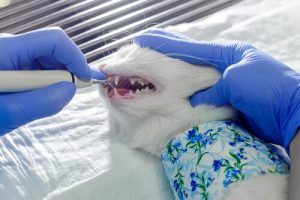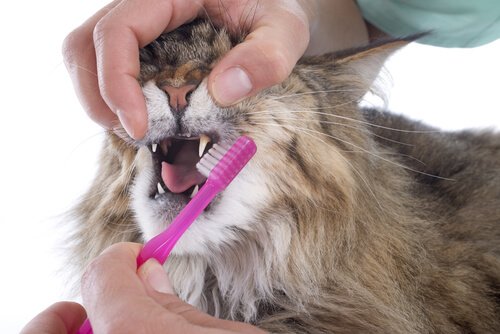Looking After Your Cat's Oral Hygiene, Step by Step

Sometimes people can take certain aspects of their pet’s hygiene for granted because they may be too complicated or they might not be so important. However, your cat’s oral hygiene is just as important as any other aspect of their health. In fact, it could even be more important because the mouth can become a haven for bacteria and infection.
How to look after your cat’s oral hygiene
Maybe you don’t know how to look after your cat’s oral hygiene, or maybe you don’t do it that often. So, read this article for some advice on looking after your cat’s oral hygiene.
First, it’s important to recognize that your cat’s oral hygiene is very important. Plaque and bacteria can build up on your cat’s teeth. When they mix with small particles of food and saliva, they become a breeding ground for bacteria, which in turn can cause a mouth infection.
Furthermore, they could develop into gingivitis, periodontitis, or cause your pet’s teeth to fall out. Not to mention all pain or problems your cat might have to deal with.
Follow the advice below in order to provide your cat with good oral hygiene.
Diet
You should take your cat’s diet into consideration. There are many foods designed to look after your cat’s teeth, such as special cat food, or treats that are meant to clean their teeth and keep them healthy.

Cats who eat a lot of raw food or wet food have more problems keeping their teeth clean because they have no need to chew as much. Cat food needs to be chewed in order to break the food down and cause friction on the teeth, which in turn cleans the teeth.
Buy high-quality food that makes your cat chew will improve your cat’s oral hygiene. Therefore, when you do clean your cat’s teeth, it’ll require less effort. Your cat will also be more receptive because they won’t be so tedious.
Accessories
The first thing you need is the right brush and toothpaste for your cat. It’s best to ask your vet for advice. Many recommend aerosol products specially designed for cats, but many cats are scared by the sound of the spray. You know your cat better than anyone else and you will know whether a spray or toothpaste will be the most appropriate.
The brush should be the right size for your cat, with soft, adaptable bristles that allow you to hit every corner of your cat’s mouth. You definitely shouldn’t be using human toothbrushes or human toothpaste.
Get your cat used to toothpaste
If you’ve never brushed your cat’s teeth before, they could get scared if you suddenly turn up with a brush that smells like menthol and try to stick it in his mouth. In order to prevent them from getting scared, get your cat used to the toothpaste by putting a little on your finger and allowing them to inspect it or lick it.

Do this for several days until you’re sure that your cat doesn’t have a problem with it. Then, you can proceed to clean your cat’s teeth.
Cleaning your cat’s teeth
Finally, at this point you should be able to clean your cat’s teeth. If you think your cat is quite jumpy and will struggle, wear long sleeves and gloves, or ask another person to help you.
Put a little toothpaste on the brush, moisten it with water, and begin to brush their teeth softly and gently without touching their gums. Once you’ve brushed your cat’s teeth, inspect their mouth carefully and then give them a treat. This way — although they may not have behaved all that well — they will associate oral hygiene with something positive and will be more receptive next time.
Obviously, all aspects of having a pet need patience and persistence. However, if you follow this advice, you’ll have no problem looking after your cat’s oral hygiene.
Sometimes people can take certain aspects of their pet’s hygiene for granted because they may be too complicated or they might not be so important. However, your cat’s oral hygiene is just as important as any other aspect of their health. In fact, it could even be more important because the mouth can become a haven for bacteria and infection.
How to look after your cat’s oral hygiene
Maybe you don’t know how to look after your cat’s oral hygiene, or maybe you don’t do it that often. So, read this article for some advice on looking after your cat’s oral hygiene.
First, it’s important to recognize that your cat’s oral hygiene is very important. Plaque and bacteria can build up on your cat’s teeth. When they mix with small particles of food and saliva, they become a breeding ground for bacteria, which in turn can cause a mouth infection.
Furthermore, they could develop into gingivitis, periodontitis, or cause your pet’s teeth to fall out. Not to mention all pain or problems your cat might have to deal with.
Follow the advice below in order to provide your cat with good oral hygiene.
Diet
You should take your cat’s diet into consideration. There are many foods designed to look after your cat’s teeth, such as special cat food, or treats that are meant to clean their teeth and keep them healthy.

Cats who eat a lot of raw food or wet food have more problems keeping their teeth clean because they have no need to chew as much. Cat food needs to be chewed in order to break the food down and cause friction on the teeth, which in turn cleans the teeth.
Buy high-quality food that makes your cat chew will improve your cat’s oral hygiene. Therefore, when you do clean your cat’s teeth, it’ll require less effort. Your cat will also be more receptive because they won’t be so tedious.
Accessories
The first thing you need is the right brush and toothpaste for your cat. It’s best to ask your vet for advice. Many recommend aerosol products specially designed for cats, but many cats are scared by the sound of the spray. You know your cat better than anyone else and you will know whether a spray or toothpaste will be the most appropriate.
The brush should be the right size for your cat, with soft, adaptable bristles that allow you to hit every corner of your cat’s mouth. You definitely shouldn’t be using human toothbrushes or human toothpaste.
Get your cat used to toothpaste
If you’ve never brushed your cat’s teeth before, they could get scared if you suddenly turn up with a brush that smells like menthol and try to stick it in his mouth. In order to prevent them from getting scared, get your cat used to the toothpaste by putting a little on your finger and allowing them to inspect it or lick it.

Do this for several days until you’re sure that your cat doesn’t have a problem with it. Then, you can proceed to clean your cat’s teeth.
Cleaning your cat’s teeth
Finally, at this point you should be able to clean your cat’s teeth. If you think your cat is quite jumpy and will struggle, wear long sleeves and gloves, or ask another person to help you.
Put a little toothpaste on the brush, moisten it with water, and begin to brush their teeth softly and gently without touching their gums. Once you’ve brushed your cat’s teeth, inspect their mouth carefully and then give them a treat. This way — although they may not have behaved all that well — they will associate oral hygiene with something positive and will be more receptive next time.
Obviously, all aspects of having a pet need patience and persistence. However, if you follow this advice, you’ll have no problem looking after your cat’s oral hygiene.
This text is provided for informational purposes only and does not replace consultation with a professional. If in doubt, consult your specialist.








